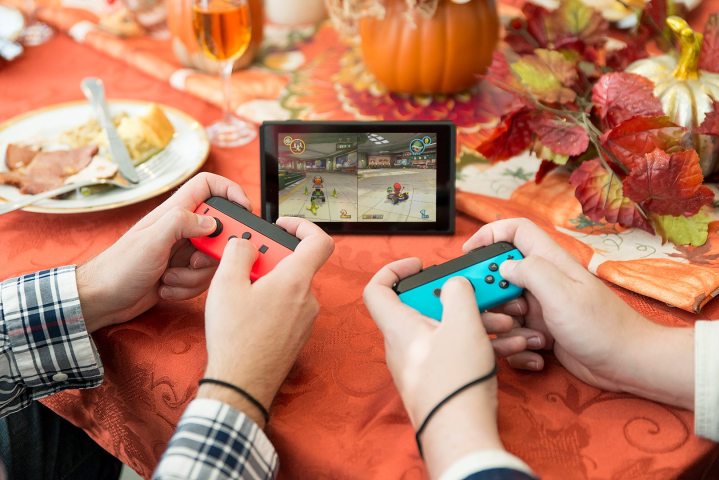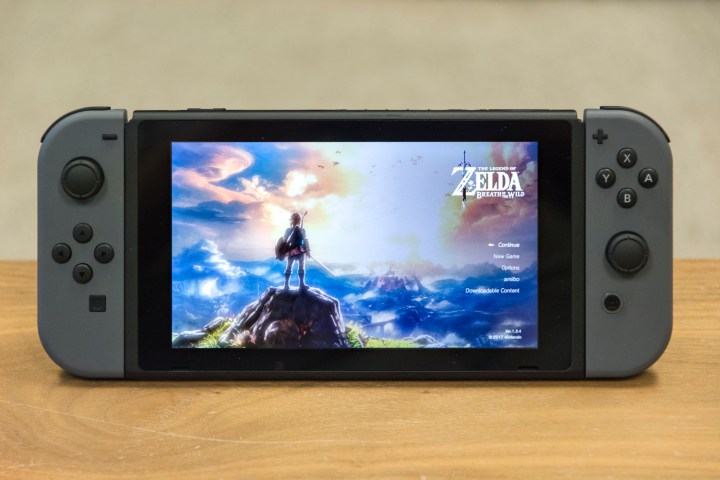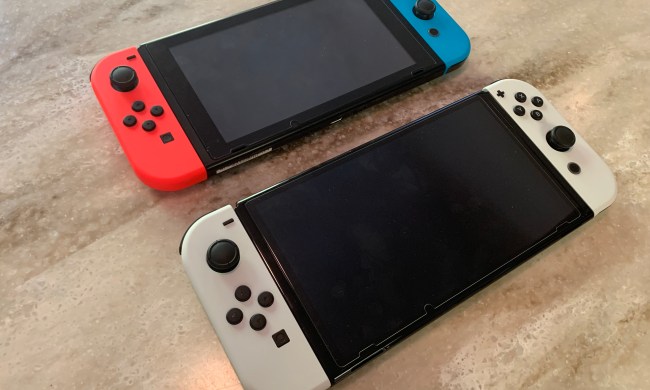The Nintendo Switch doesn’t have a lot going on at first glance. Pop in a game card or browse the eShop, select your game, and you’re off to the races. To get the most out of your Switch, you’ll need to go beyond that. From protecting the handheld console from falls to downloading games only available in other parts of the world, here are the best Nintendo Switch tips and tricks.
- Expand your storage space
- Get a case and a screen protector
- Buy a Pro Controller
- Turn off Wi-Fi to save battery
- Get an external battery
- Beware of third-party docks
- Use your Switch to turn on your TV
- Change the system’s sound effects
- Make multiple profiles for more save slots
- Access region-exclusive games on the eShop
- Plug in a keyboard — or any other USB accessory you might need
- Use Joy-Cons as Bluetooth devices
- Find your lost Joy-Cons
- Archive, don’t delete your games
- Keep your save data safe in the cloud
- Use your points to get discounts
- Boot to recovery mode
Further reading
- Best Nintendo Switch games
- Best Nintendo Switch games under $20
- How to gameshare on a Nintendo Switch
Expand your storage space
There are many great things about the Switch. Its internal storage capacity is none one of them.
The Switch comes with 32GB of built-in storage, which is not enough to play many games. Some titles already require more space than that, including Dragon Quest Heroes. So if you’re planning on playing just about anything other than The Legend of Zelda: Breath of the Wild or Super Mario Odyssey, you’ll probably want to grab a hefty-sized microSD card. It sucks, we know, but they aren’t too expensive.
You can get large-capacity microSD cards for relatively little cash these days, and depending on the speed, you might already have a compatible card. Unlike the PlayStation Vita, the cards used for the Switch aren’t proprietary. Even if you buy physical games, mandatory content updates on many of them contain the rest of the game files, so there isn’t any getting around purchasing one.
Get a case and a screen protector
The Nintendo Switch can be a portable system, but this isn’t like your old DS or Game Boy Advance SP — you’ll want to get a case so it isn’t damaged while you’re out and about. Depending on your needs, there are several different cases to choose from, including slim ones designed to go in a backpack and larger, sturdier cases that can also hold a variety of accessories. Choose the one that best suits your style, but don’t feel weird if you need to buy a second case later on.
One other must-have protection accessory is a screen protector. There are extra-sturdy glass protectors available as well as plastic ones, which will mostly prevent scratches, but a flaw in the design of the console’s dock can lead to it scuffing the screen when the system is inserted or removed. If you have a protector on the screen, that will be scratched instead of the screen itself, and you can easily replace it instead of sending your system in for a repair.
Buy a Pro Controller
It’s technically optional, but we consider Nintendo’s Switch Pro Controller a must-have accessory. It’s a lot gentler on the joints than the default Joy-Cons, making it perfect for marathon sessions of Breath of the Wild. It also still has the motion control features found in the Joy-Cons, and the more traditional directional pad and larger face buttons give you the home console experience that the smaller controllers can’t offer. A few carrying cases also contain slots to hold your Pro Controller so you can take it with you.
Turn off Wi-Fi to save battery

While Nintendo’s latest hardware isn’t as powerful as its cousins from Microsoft and Sony, it still packs quite a bit of performance into a very small frame. Sometimes, though, background processes and the like can tax the hybrid’s scant computing resources and cause framerate slowdowns. Some users have found that disabling Wi-Fi auto-connect helps quite a bit, particularly when you’re in handheld mode.
The Switch likes to search for new access points when it can, and unless you tell it otherwise, even if it has a great network connection, it can still periodically scan the airwaves and muck with your gaming session. To shut this off, head into the main system settings and select Airplane Mode. This will not work when docked, but that also means you don’t need to worry about battery life.
Get an external battery
Try as you might to extend the life of your Switch’s battery, it’s eventually going to die, but that doesn’t mean you have to stop playing it when you’re on the go. With an external battery pack, you can charge the Switch without needing to plug it into a wall charger or the dock. Look for ones that output around 10.5 watts of power, and check out our list of recommended packs to make your life a little easier.
Another option is the S-Charge Nintendo Switch case, which includes a massive 10,000mAh battery as well as an improved kickstand so you can play local multiplayer with friends for hours, all without worrying about your Switch dying. As a bonus, the S-Charge can charge your phone through its USB ports.
Beware of third-party docks
Nintendo sells the Switch dock for around $90, and although it’s expensive to shell out nearly $100 for some plastic and a couple of ports, you should stick with the first-party option. The Switch has some strange rules when it comes to how it draws power. If you use any USB-C cable or an unofficial dock, you run the risk of bricking your device.
NYKO released a smaller Switch dock in 2017, and a few months later, Nintendo updated the Switch with its 5.0.0 firmware. A few days later, popular YouTuber Spawn Wave released a video showing how the third-party dock bricked his Switch after the update. Although there are plenty of users who use third-party docks without any problems, it’s best to err on the side of caution.
Use your Switch to turn on your TV
Similar to the PS4, your Switch can power on your TV whenever you insert it in the dock. It’s enabled out of the box, but if you want to double check, follow System Settings > TV Settings > Match TV Power State. Make sure that last setting is turned on. This feature is enabled by HDMI-CEC, which allows external devices to control the HDMI input. Most modern TVs support HDMI-CEC, but each brand has a different name for it (LG uses SimpLink while Samsung uses Anynet+, for example). You can find a full list of trade names here.
Change the system’s sound effects
If you’re a fan of quirky Easter eggs, this is for you. When you’re getting ready to play a game from sleep, the console will ask you to mash some button three times. Most players will tap one of the obvious ones, like the “A” button, which we’ve all been trained practically from birth to recognize as video game for “OK.” But if you click the joystick or mash a shoulder button instead, you’ll get some funny sound effects. Fans of the GameCube will recall a similar technique that changed the console’s startup sound to anything from clown horns to bizarre squeaks.
Make multiple profiles for more save slots

The Switch has a ton of exceptional games — Breath of the Wild, Super Mario Odyssey, Splatoon 2, etc. — but many only allow one save file. That can pose a big problem for players who like to keep multiple files. It can also be painfully easy for new players to inadvertently wipe your data — lookin’ at you Breath of the Wild.
It isn’t ideal, but you can get around this by making multiple user accounts — either for yourself or for others. This is pretty simple, but by default, the Switch doesn’t tell you how or suggest it as a means to protect your save files. When starting any game from the home screen, you’ll see your default Mii pop up. Select the “+” and then enter in all the details of your new profile. Given how easy it is to set up personalized accounts on just about every console and media service already, that shouldn’t be too much trouble.
Access region-exclusive games on the eShop
Making new accounts has a bonus — you can use your console across regions. For the unfamiliar, manufacturers of audiovisual hardware have been locking down devices to prevent people from watching foreign movies or television for decades. Initially, the purpose was to ensure that different equipment worked properly, an extension and partial byproduct of having different plug types in Europe than the U.S. or Japan. Now, though, it’s often used to prevent people from buying content that wasn’t released in their region.
The Switch’s hardware can run games from all over the world, however. All you need is an account set to that region. To do that, you need to head to accounts.nintendo.com, then select your account’s country of residence and flip it to whatever you need. At the time of writing, you can freely change your home nation. You’ll want to make sure your bank or credit/debit card supports international transactions (not all do).
Head back to your Switch and create a new account using the process described above. This time, though, link the Switch profile with your new Nintendo account. From then on, you can choose the region of the eShop you want to shop by selecting the correct profile.
Plug in a keyboard — or any other USB accessory you might need
The Switch has surprising interoperability with all kinds of devices. You can, for instance, connect a USB keyboard or press the console into service as a backup battery for certain laptops. Most (but not all) USB wizardry will require the console to be docked.
We found that, while docked, many USB keyboards work straight away — allowing you to type far faster. The Switch now natively supports USB headphones, and you can use them either docked or undocked.
We also found that simply plugging some USB-C devices into the console’s charging port made the power flow reverse and charge another device instead. We charged a current-generation MacBook with a Switch, as well as a Samsung Chromebook Plus. Of course, this is a bit slapdash and not especially helpful, but it’s pretty cool.
Use Joy-Cons as Bluetooth devices
The primary controllers for the switch are a pair of motion-sensitive, advanced gadgets called Joy-Cons. But, there’s a lot more you can do with them besides using them for busting up boulders in Stardew Valley or smacking Pokemon senseless in Pokkén Tournament DX.
For starters, the controllers can be easily paired with other Bluetooth devices, like your computer. On a standard PC, you need only open up your computer’s settings, select Bluetooth and Other Devices, select Add Bluetooth or Other Device, then hit the small black sync buttons on the controllers to pair with your PC. That’s it.
Find your lost Joy-Cons
If you’ve misplaced your Joy-Cons, fear not! You can find them easily. On your console, select Controllers from the root menu, then Find Controllers. After you pick which paired device you want to track down, they’ll start buzzing and buzzing until you find them. It’s like having a roommate call your phone. Only it’s your Switch calling your controllers.
Archive, don’t delete your games
This tip likely falls into the “weird Nintendo stuff” category. Many gamers think of Nintendo as an old friend, but one that’s always been just a little bit self-sabotaging. Whether it’s the borked online play or artificial scarcity, sometimes it seems Nintendo isn’t on its own side.
In this case, downloading digital games you’ve purchased and deleted is less intuitive on the Switch than it is on other consoles. There is no easily accessible “purchased games” or “extended collection” in your Switch’s home library. Instead, if you’re running low on memory and have to free up some storage space, we recommend “archiving” your software, rather than deleting it. Archiving deletes the game data from your Switch but leaves the game in your library.
You can do this by selecting Options for any bit of software on the home screen. From there, select Manage Software and then Archive Software. This leaves the icon for the game on your home screen and retains your game saves, but deletes the game itself. When you’re ready to play again, you need only select the title and then download the game. Simple.
It’s worth noting that even if you delete your game, you still own the license to it. Although it won’t show up in your library, you can download any game you’ve purchased through the eShop.
Keep your save data safe in the cloud
Following an update to the Nintendo Switch’s system software, you can now keep your game data safe by storing it in the cloud, so long as you have Nintendo Switch Online. If your Switch happens to break or you simply decide to use a different one for whatever reason, you’ll be able to keep your save data. However, this will not work with all games — Pokémon Sword and Shield are notable exceptions, so make sure you look up information on your games before doing so.
To store your game save data in the cloud, select a game tile on the system’s home screen, hit the “+” icon, and choose the Save Data Cloud Backup option. Depending on your firmware, it might just say Save Data Cloud instead.
Click the tile that appears, and you’ll be taken to a page for the game in question. From there, you can back up your save data, download your save data, delete backup save data, or turn automatic backup on. You’ll also see if there is a difference between your console’s save data and the cloud’s on this page.
Use your points to get discounts
The price you see on the Nintendo Switch eShop doesn’t necessarily have to be the price you pay! As you buy games — both digital and physical — you’ll accrue My Nintendo points, which are used to purchase goodies and get discounts on games.
If you bought your game digitally, the My Nintendo points you get are added to your account automatically. This option typically gives you a set number of points, but there are occasional promotions that will reward your account with more.
For physical games, select the game’s icon on the system’s home screen and hit the “+” icon. Select My Nintendo Rewards Program and choose Earn Points. If the game you purchased is still eligible, points will be added to your account. These do have an expiration date, however, so redeem them as soon as you start your game.
Next, choose a Nintendo Switch game you want from the eShop. Pick Proceed to Purchase, and on the next page, you’ll see Redeem Points underneath the price. Select this option, and depending on your point total, you can knock several bucks off the cost of your game.
Take advantage of this; for every dollar you dole out on a digital game, the system will give you five points back. So, for a $60 digital game, you can get rewarded with 300 additional points. We cannot recommend this more— retail-box games typically only reward players one point per every dollar they spend.
The points do eventually add up; each specific point is the equivalent of a penny. That means our 300 points from before would give us a $3 credit online.
Boot to recovery mode
Recovery mode is an excellent tool employed by Switch manufacturers; you can use it to get to the bottom of any issues you may be experiencing with your console. To access the recovery mode tool, press and hold both volume buttons simultaneously. Then, press the power button. It’s best that you power cycle your Switch when attempting to do this; You’ll find that recovery mode won’t work while the console’s in sleep mode.
If you can’t navigate to your system settings page, recovery mode can also help you finish system updates for your Switch. The feature resembles Windows’ safe mode, except it’s designed explicitly for your game console and not a PC.



